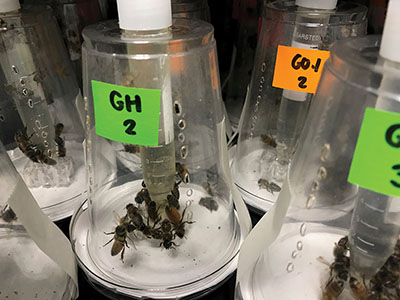
This month’s “Notes from the Lab” is a bit different than usual. Because the focus of the January issue of ABJ is on pesticides, we’re going to highlight a topic rather than a single recent study. And whether you know it or not, it’s the topic that’s causing much of the “controversy” surrounding pesticides lately. This is the topic that many of those studies published in top journals, then interpreted for you via the popular press, often face criticism over.
The topic – pesticide risk to bees – is actually two topics. This is because any risk assessment for pesticides must take into account both exposure (i.e., how much pesticide bees are exposed to in the field) and effects (i.e., the impact of that pesticide on bees). Unfortunately, it’s very hard to address both exposure and effects in a single study. Thus, more often than not, individual studies are published that assess either exposure or effects, then make assumptions about the other.
So, what’s the problem? Can’t effects studies trust the exposure literature (and vice versa)? This approach does work well sometimes. For example, hundreds of studies have been conducted over the past ~15 years regarding exposure to and effects from neonicotinoids (particularly imidacloprid, thiamethoxam and clothianidin). Thus, we have a good understanding of both neonicotinoid exposure to bees and effects of those neonicotinoids on bees across a range of environmental contexts. New studies therefore have a broad knowledge base to tap into when designing experiments and making inferences about pesticide risk.
But, unfortunately, this broad knowledge base isn’t available for all pesticides. In fact, it isn’t available for most pesticides. Researchers know this and are very good at discussing the results from their studies appropriately. But most people read the popular press, not the original studies, and the popular press often extends inference beyond what a single study is capable of inferring. This is what can cause the “controversy” regarding pesticide risk to bees.
Our goal here is to illustrate how such controversy can occur using two examples that you’ve likely seen in the news lately. We are in no way critiquing the excellent science conducted in these studies (which we do believe is excellent). Instead, our goal is to point out that individual studies rarely assess pesticide risk, even though the popular press would have you believe they do. Thus, while the studies are very important contributions, they should be considered discussion starters, not discussion enders. In other words, each study finds very important results, but how those results should be interpreted regarding pesticide risk to bees requires further study.
“Common weed killer linked to bee deaths.” This is the title of one popular press article highlighting the study titled “Glyphosate perturbs the gut microbiota of honey bees,” written by Erick Motta and colleagues and published in the journal Proceedings of the National Academy of Sciences [115:10305-10310 (2018)]. It’s quite an attention-grabbing title for a newspaper. Clearly, you might think, we’ve found that the weed killer glyphosate (an ingredient in most RoundUp products) is responsible for the unsustainable losses of honey bee colonies currently experienced throughout the world. But what does the study really show?
Motta and colleagues conducted a pesticide effects study, showing that laboratory-based exposure of individual bees to 5-10 parts per million (ppm) glyphosate for 5 days (or 169 ppm glyphosate for 2 days) alters the bacterial communities in honey bee guts and can cause the bees to be more susceptible to a bacterial pathogen, Serratia marcescens. These are very interesting results and the level of mechanistic detail in the study is spectacular. At the same time, it’s important to point out that inference regarding risk to bees depends on whether the exposure levels utilized for the effects assays (i.e., 5-10 ppm glyphosate exposure for 5 days, or 169 ppm exposure for 2 days) could be expected in the field.
What do we know about glyphosate exposure to bees in the field? Not much, unfortunately. Glyphosate levels are rarely assessed in bee products (i.e., honey, pollen, wax) because the analysis is expensive (hundreds of dollars per sample) and requires different methods than standard multi-residue pesticide analyses. The study containing the best exposure data is titled “Evaluating exposure and potential effects on honeybee brood (Apis mellifera) development using glyphosate as an example,” written by Helen Thompson and colleagues and published in the journal Integrated Environmental Assessment and Management [10:463-470 (2014)]. In this study, the authors found that glyphosate concentrations in nectar and pollen could be near the range manipulated by Motta and colleagues: >5 ppm in nectar collected 3.5 days after spraying, and >300 ppm in pollen collected 2 days after spraying. But it’s worth pointing out that Thompson and colleagues’ study was conducted in a greenhouse where the bees were restricted to foraging only on treated plants in full bloom, and field conditions that could reduce concentrations in nectar and pollen (e.g., precipitation, exposure to UV light) were minimized or absent. It’s also worth pointing out that ….


